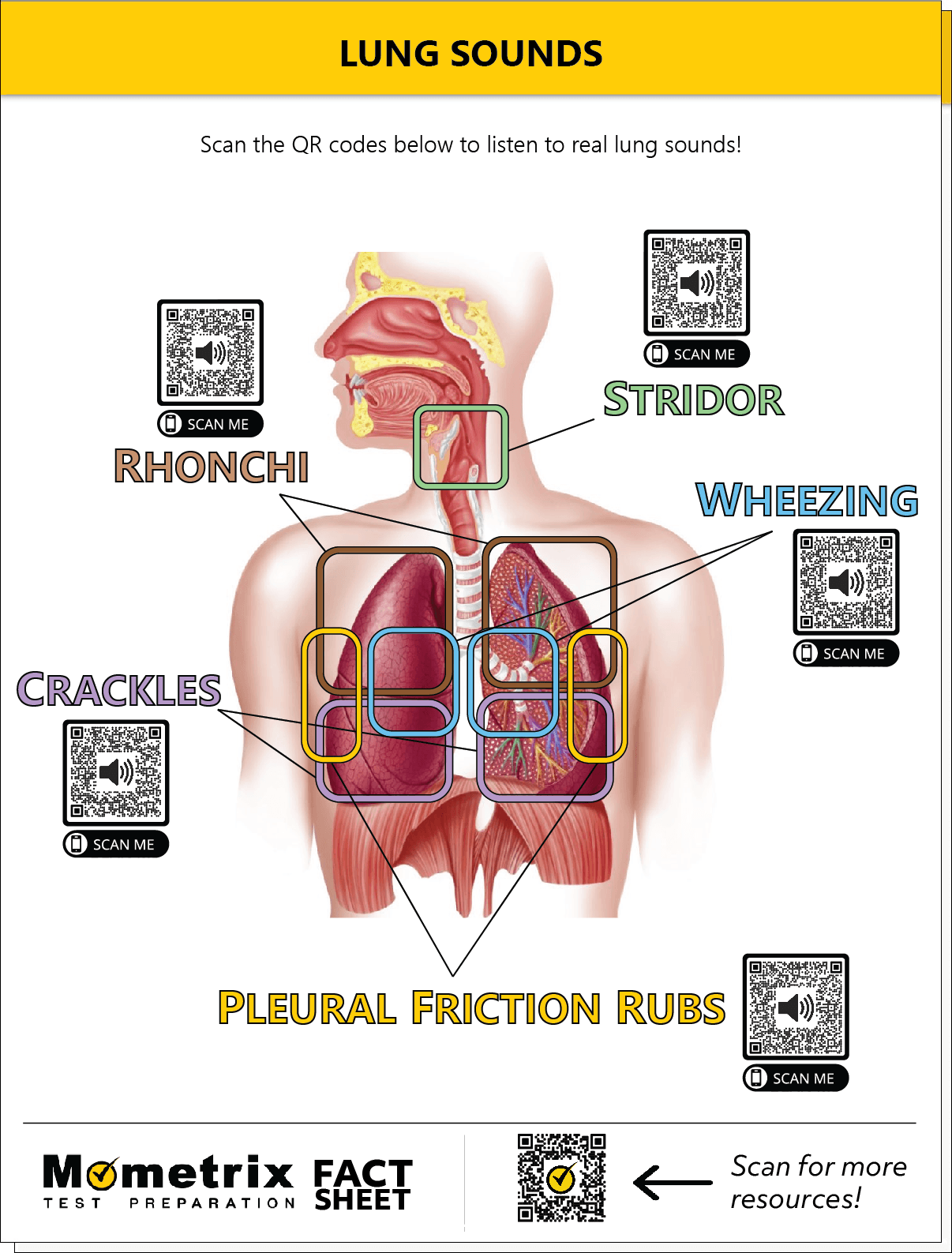
Hi, and welcome to this video on lung sounds! Lung sounds, or breath sounds, refer to the sounds heard when air moves through the respiratory system. These are easily identified by auscultation, or listening to the lungs fields with the stethoscope. The lung sounds are classified according to the sounds involved during inhalation and exhalation phases of the breath cycle, taking note of the pitch and intensity.
Types of abnormal breath sounds include wheezing, rhonchi (which sound like low-pitched wheezing), stridor, crackles (also known as rales, and these may be further classified as fine or coarse), and pleural friction rub. Let’s start with wheezing.
Wheezing
Wheezing is caused by the narrowing of the airways and is associated with asthma, bronchitis, pneumonia, COPD, smoking, heart failure, inhaling a foreign object into the lungs, or an allergic reaction.
Wheezing sounds may occur during inhalation or exhalation and are continuous with a musical quality. The classic wheeze refers to the high-pitched whistle-like sound heard during exhalation as air moves through a narrow or obstructed airway.
Listen to the following wheezing lung sounds:
A wheeze may also be lower-pitched, having a snoring or moaning quality in which they are referred to as rhonchi.
Rhonchi
Rhonchi sounds have a continuous snoring, gurgling, or rattle-like quality. Rhonchi occur in the bronchi as air moves through tracheal-bronchial passages coated with mucus or respiratory secretions.
This is often heard in pneumonia, chronic bronchitis, or cystic fibrosis. Rhonchi usually clear after coughing.
Stridor
Stridor is a high-pitched musical sound heard on inspiration, which resembles wheezing. When listening with a stethoscope, if the sound is louder over the throat, it is stridor, not wheezing. Air is moving roughly over a partially obstructed upper airway. Stridor is caused by something blocking the larynx, such as a person choking on an object.
Stridor can also be heard in a person with an infection, swelling in the throat, or laryngospasm. You may frequently hear stridor in children, as they are more likely to choke and more likely to get childhood infections like croup. Stridor can indicate a medical emergency if not enough oxygen is able to get through the airways.
Listen to the following stridor lung sounds:
Crackles
Previously termed rales, crackles are sounds that are heard in the lung field that has fluid in small airways. Crackles can be heard on inspiration and expiration. Early inspiratory and expiratory crackles are heard in chronic bronchitis. Late inspiratory crackles may indicate pneumonia, CHF, or atelectasis, a complete or partial collapse of a lung or lobe of a lung.
They are broken down into fine crackles and coarse crackles. Fine crackles are high-pitched, brief, discontinuous popping lung sounds. Fine crackles sound like wood burning in a fireplace or cellophane being crumpled. Fine crackles usually start at the base of the lungs where there is fluid in the lungs. As the fluid fills the lungs more, fine crackles can be heard closer and closer to the top of the lungs.
Coarse crackles sound like coarse, rattling, crackling sounds that are louder, longer, and lower in pitch than fine crackles. They are described as a bubbling sound, as when pouring water out of a bottle or like ripping open Velcro. Coarse crackles are often heard just in certain spots in the lungs, possibly only on one side or in different spots on both sides. They are usually caused by mucus in the bronchi.
Listen to the sound of course crackles in a patient with pneumonia:
Pleural Rubs
Pleural rubs occur when two inflamed pleural surfaces rub against each other during respiration. This is often heard in pleurisy, or inflammation of the tissues that lie in the lungs and chest cavity. The sound may be continuous or broken and creaking or grating.
It can be described as the sound of walking on fresh snow or rubbing leather together. The sound of pleural rubs occurs every time the patient inhales and exhales. Pleural rubs come and go, are not altered with coughing, can usually be localized to a specific location on the chest wall, and will stop when the patient holds their breath.
Remember, if there is a loss of breath sounds in an area, it probably indicates a pneumothorax, or a collapsed lung, in which there is no air movement in that area.
Let’s go over a quick review.
Review
Wheezing is a musical noise during inspiration or expiration, usually louder during expiration, and continuous. Rhonchi resemble low-pitched wheezes. They are rumbling, coarse sounds like a snore during inspiration or exploration, and continuous. It may clear with coughing. Stridor is a high-pitched musical sound heard on inspiration resembling wheezing. However, the sound is louder over the throat due to a partially obstructed airway. Crackles are high-pitched discontinuous sounds during inspiration not cleared by a cough and further defined as fine and coarse. Pleural friction rub occurs during inhalation and exhalation, may be continuous or broken and creaking or grating. They stop when the patient holds their breath.
Thank you for watching this video on lung sounds!
Frequently Asked Questions
Q
What are the three normal lung sounds?
A
The three normal/healthy lung sounds include bronchial, bronchovesicular, and vesicular lung sounds. These sounds are heard on auscultation of various regions of the respiratory tract and indicate the healthy and functional passing of air through the lungs and trachea.
Q
What are the most common abnormal lung sounds?
A
The most common abnormal/dysfunctional lung sounds are wheezes, crackles/rales, rhonchi, stridor, and pleural friction rub. These noises are heard due to inflammation, dysfunction, or fluid in the respiratory tract and indicate suboptimal respiratory functioning. These sounds can be heard on auscultation in both acute and chronic illness.
Q
What are bronchial lung sounds and where are they heard?
A
Bronchial lung sounds are normal lung sounds heard over the center chest/sternum on inspiration and expiration. They are characterized by the loud, hollow, tubular, high-pitched sound of air passing through the windpipe without obstruction. They should sound roughly the same on inspiration as they do on expiration.
Q
What are bronchovesicular lung sounds and where are they heard?
A
Bronchovesicular lung sounds are heard where the bronchi enter the lungs, best auscultated over the anterior upper lung fields (first and second intercostal spaces) and over the posterior lungs. These lung sounds are muffled when compared to bronchial lung sounds, but are tubular in nature, medium in pitch, and equal in inspiration and expiration.
Q
What are vesicular lung sounds and where are they heard?
A
Vesicular lung sounds are soft blowing sounds heard over the entire lung field during both inspiration and expiration, though they diminish during the end of expiration. These are low in pitch when auscultated in healthy lungs.
Q
What are wheezing lung sounds and where are they heard?
A
Wheezing sounds may occur during inhalation or exhalation. Most commonly, they are a high-pitched, whistle-like sound heard during exhalation while auscultating the lungs. Wheezing is caused by the narrowing of the airways and is associated with asthma, bronchitis, pneumonia, COPD, smoking, heart failure, inhaling a foreign object into the lungs, or an allergic reaction.
Q
What are crackles/rales and where are they heard?
A
Crackles/rales are sounds that are heard when the lung field has fluid in small airways. Crackles can be heard on inspiration and expiration. Early inspiratory and expiratory crackles are heard in chronic bronchitis. Late inspiratory crackles may indicate pneumonia, CHF, or atelectasis, a complete or partial collapse of a lung or lobe of a lung. Crackles can also be considered fine (high-pitched) or course (louder and lower in pitch).
Q
What are rhonchi and where are they heard?
A
Rhonchi sounds have a continuous snoring, gurgling, or rattle-like quality. Rhonchi occur in the bronchi as air moves through tracheal-bronchial passages coated with mucus or respiratory secretions. This is often heard in the upper lung field in the presence of pneumonia, chronic bronchitis, or cystic fibrosis. Rhonchi usually clear after coughing.
Q
What is stridor and where is it heard?
A
Stridor is a high-pitched, musical sound heard on inspiration. The sound is similar to wheezing, but heard over the throat. It is the sound of air moving roughly over a partially obstructed upper airway. Stridor is caused by something blocking the larynx, such as a person choking on an object.
Q
What is pleural friction rub and where is it heard?
A
Pleural rubs occur when two inflamed pleural surfaces rub against each other during respiration. This is often heard in pleurisy, or inflammation of the tissues that lie in the lungs and chest cavity. The sound may be continuous or broken and creaking or grating. It can be described as the sound of walking on fresh snow or rubbing leather together and is most commonly heard in the base of the lungs.


